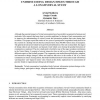Free Online Productivity Tools
i2Speak
i2Symbol
i2OCR
iTex2Img
iWeb2Print
iWeb2Shot
i2Type
iPdf2Split
iPdf2Merge
i2Bopomofo
i2Arabic
i2Style
i2Image
i2PDF
iLatex2Rtf
Sci2ools
ICIS
1997
1997
Evolution of a virtual community: understanding design issues through a longitudinal study
Although the potential impacts of virtual communities have been widely recognized in business and academia, little research has been done to provide guidelines for design of such communities and to improve the understanding of critical events and interaction patterns that arise during their evolution. This paper reports the results of two years of participative longitudinal study that led to the creation of a leading web site that has attracted more than 300,000 visitors since its inception. The patterns of interaction which led to growth and stabilization of the site are described, the impact of design choices are discussed, and typical events which occur during the gradual formation of community are analyzed. The site is dedicated to football at one of the major academic institutions in the United States. It consists of several interactive fora as well as over 50 pages pertaining to different aspects of the football program. The community was studied through initiation, adoption, an...
| Added | 01 Nov 2010 |
| Updated | 01 Nov 2010 |
| Type | Conference |
| Year | 1997 |
| Where | ICIS |
| Authors | Arvind Malhotra, Sanjay Gosain, Alexander Hars |
Comments (0)

